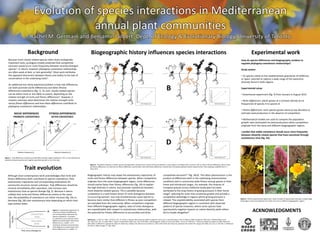
ESA Portland 2012 poster
- 1. Evolution of species interactions in Mediterranean annual plant communities Rachel M. Germain and Benjamin Gilbert; Dept. of Ecology & Evolutionary Biology, University of Toronto Background Biogeographic history influences species interactions Experimental work Because more closely related species often share ecologically- How do species differences and biogeography combine to important traits, ecologists initially predicted that competitive regulate phylogeny-coexistence relationships? exclusion would occur more frequently between recently diverged species1. In nature, however, phylogeny-coexistence relationships Study system are often weak at best, or lack generality2. Most work attributes this apparent disconnect between theory and reality to the lack of • 32 species native to the mediterranean grasslands of California conservatism in the underlying traits3. or Spain, selected to capture a wide range of the taxonomic diversity found in both regions An additional but rarely examined problem is that trait differences can both promote (niche differences) and deter (fitness differences) coexistence (fig. 1). As such, closely related species A A B Experimental setup Exotic frequency (t + 1) Exotic frequency (t + 1) 1:1 1:1 can be either more or less likely to coexist, depending on the • Greenhouse experiment (fig. 4) from January to August 2012 relative strength of niche and fitness differences4. However, it remains unknown what determines the relative strength niche • Niche differences: plants grown at a constant density at six versus fitness differences and how these differences contribute to Exotic frequency (t) Exotic frequency (t) frequencies of species A to species B phylogeny-coexistence relationships. • Fitness differences: each species grown alone at low densities to NICHE DIFFERENCES FITNESS DIFFERENCES estimate seed production in the absence of competition PROMOTE COEXISTENCE DETER COEXISTENCE • Mathematical models are used to compare the population 1:1 1:1 growth rates (estimated via seed production) when competitors originate from the same and different biogeographic regions Relative frequency (t + 1) Relative frequency (t + 1) I predict that stable coexistence should occur more frequently between distantly related species that have coevolved through evolutionary time (fig. 2A). C D Exotic frequency (t + 1) Exotic frequency (t + 1) 1:1 1:1 Relative frequency (t) Relative frequency (t) Figure 1. Trait differences can both promote (left) and deter (right) coexistence. The 1:1 line indicates the Exotic frequency (t) Exotic frequency (t) boundary between positive and negative population growth in one time step. Figure 3. Population dynamics of exotic species (orange) when introduced to a native community (black) in a new region, according to four scenarios: (A) no niche or fitness differences, (B) no niche Trait evolution but fitness differences, (C) niche but no fitness differences, and (D) both niche and fitness differences. Dashed lines in drawing represent distinct spatial niches. Plant drawings modified from F. L. Pérez 2011. Although most contemporary work acknowledges that niche and Biogeographic history may shape the evolutionary trajectories of competitive exclusion6,7 (fig. 3B,D). This latter phenomenon is the fitness differences both contribute to species coexistence, their niche and fitness differences between species. When competitors product of differences both in the underlying environmental evolutionary trajectories and corresponding implications for originate from the same biogeographic region, niche differences conditions and in community-wide fitness among species in their community structure remain unknown. Trait differences should be should evolve faster than fitness differences (fig. 2A) to explain home and introduced ranges. For example, the invasion of minimal immediately after speciation, and increase over the high diversity in nature, and promote coexistence between European grasses across California landscapes has been evolutionary time as species diverge (fig. 2). Because it seems more distantly related species. This is possible because attributed to the long history of grazing pressure in their home unlikely that niche and fitness differences evolve at the same competition is a well-known driver of niche divergence between range8, selecting for traits that accelerate growth and provide a rate, the probability of coexistence can either increase (fig. 2A) or co-occurring species5, but may simultaneously cause species to competitive advantage in regions where grazing pressure is Figure 4. Photos of greenhouse experiment, which includes 16 species pairs that span a broad range decrease (fig. 2B) over evolutionary time depending on which trait- become more similar than different in fitness as poor competitors relaxed. The unpredictability associated with species from of divergence times and originate from either the same or different biogeographic regions. type evolves faster. are excluded from the community. When competitors originate different biogeographic regions is consistent with observed from different biogeographic regions, rates of niche divergence patterns of species invasions, where some species have A Figure 2. Evolutionary trajectories of are unpredictable with respect to evolutionary relationships, with spectacularly negative impacts on native diversity while others ACKNOWLEDGMENTS Coexistence metric niche (α) to fitness (λ) differences the potential for fitness differences to accumulate and drive fail to invade altogether9. COEXISTENCE and corresponding implications for species coexistence. In scenario (Δα/Δλ) ZONE 1 A, coexistence occurs because niche References: 1. Elton CS, 1946, J. of Anim. Ecol. 15: 54-68; 2. Swenson NG, Enquist BJ, 2009, Ecology 90: 2161-2170; 3. Cavender-Bares J, Keen A, Miles B, 2006, Ecology 87: S109-122; 4. Mayfield MM, Levine EXCLUSION differences evolve faster than fitness JM, 2010, Ecol. Lett. 13: 1085-1093; 5. Dayan T, Simberloff D, 2005, Ecol. Lett. 8: 875-894; 6. MacDougall AS, Gilbert B, Levine JM, 2009, J. of Ecol. 97: 609-615; 7. Strauss SY, Webb CO, Salamin N, 2006, PNAS 103: differences (i.e., Δα/Δλ > 1). In ZONE scenario B, exclusion occurs because 5841-5845; 8. Mitchell CE, Agrawal AA, Bever JD, Gilbert GS, Hufbauer RA, Klironomos JN, Maron JL, Morris WF, Parker IM, Power AG, Seabloom EW, Torchin ME, Vazquez DP, 2006, Ecol. Lett. 9: 726-740; 9. Williamson M, Fitter A, 1996, Ecology 77: 1661-1666. B niche differences evolve slower than fitness differences (i.e., Δα/Δλ < 1). Time since divergence